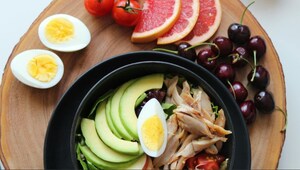How to Make Your Soups Even Healthier
And by healthy we don't mean bland

I have loved soup since childhood. My Jewish upbringing meantchicken soup was served every Friday evening and Saturday without fail. My mother would boil the chicken for hours and, although the flesh tasted like cardboard, the soup itself was delicious. It has been called 'Jewish penicillin' so it's no surprise that some research has confirmed that it may help your immune system.
I always make my own soup because I find many of the ready-made versions have quite high levels of salt and sugar on their list of ingredients and sometimes high-calorie cream too. It reduces the benefits of something that is fundamentally healthy.
Focus on bold colours
Tom Arad, an independent naturopathic nutritionist from London, whose expertise is treating food as a form of medication and healing, is also a soup fan.
He says:
"Soup is a great way of getting minerals and vitamins into the body. I recommend using rainbow colours, particularly green, orange and red as they contain calcium, potassium, iron, magnesium, vitamin B-complex, A, C and K. Green vegetables such as broccoli, spinach and leeks are particularly healthy. Green herbs, like parsley, dill and coriander, are a must too. Parsley, for example, is packed with iron and vitamin C. Some people find the taste bitter, but if you put a little into a soup — and the milder leaf parsley is just as healthy as the curly kind — you won't notice it's there and you'll still get its health benefits."
He adds:
"Orange or red vegetables, like carrots, butternut squash and sweet potato, healthier than a regular potato, contain Vitamin A, an antioxidant that is good for eyesight and the skin, and boosts the immune system."
My top soup hacks
I take lots of short cuts to save time. I make all my soups in bulk, and freeze at least half for another day. It means I can take my pick of what I fancy, especially if the weather turns nasty or you need an easy (but healthy) lunch idea. I also believe life is too short to dice vegetables into equal small pieces. I cut everything into largish chunks, which I liquidise once the soup is cooked.
My short-cut has health benefits too - blended soups stay in the stomach longer than chunks of vegetables, which helps to keep hunger pangs at bay and makes it slightly easier to lose weight. Boiling vegetables as an accompaniment to a main meal results in some of the nutritional value being lost in the water, which is usually thrown away. Making soup with vegetables means the nutrients stay in the liquid.
Bone broth versus vegetables
"Bone broth needs several hours of cooking to release its nutrients, while many vegetable soups will cook in twenty minutes," says Tom. He adds that, although some nutrients will be lost during preparation, most quality minerals and vitamins will remain in the soup - but it's best not to let them get too soft. Pulses take a little longer.
Recipe? What recipe...
Nor do I use a recipe. Soup doesn't have to be rigidly made, and I like to experiment so that each soup is never quite the same. I tend to avoid using just one vegetable, like tomatoes or mushrooms, as having a larger variety is a nutritional boost.Tomatoes with red pepper and leeks with mushrooms are tastier and better for you.
The base of virtually all my soups is carrots, onions and garlic, which have anti-bacterial, antiseptic and anti-inflammatory qualities.
Via
more from Life

The finest eateries across Mumbai, Goa, Hyderabad, Bengaluru, Delhi, and Pune

4 uncircumcised penis myths we need to stop believing

Sex tips to keep in mind during this Mercury Retrograde

What is intuitive eating and how is it different from other diets?

Just calculated Taylor Swift’s net worth and now I’m crying

8 vanilla-infused beauty products for summer

#AllEyesOnB: Beauty launches on our radar this April

Your most pressing questions about Bipolar 1 Disorder, answered by people who know

What the first trip with your partner says about your relationship

Signs that you’re a bad packer on your holidays and how to avoid them
